As you may know, I’m a collector of video games. All systems, all eras. I I like picking up asexual-adjacent games, like “Ace Attorney”, “Ace Combat”, “Ace of Aces”, “Cake Mania”, and “Dragon Warrior”. However, some of my most favorite pieces in the collection are the ones I had to import from an alternate dimension because they don’t exist in our universe. That brings me to the game I want to talk about today.
Setting the Scene
It’s late October 1987. Fatal Attraction and The Princess Bride are on top of the box office, Michael Jackson’s Bad is tearing up the charts, and millions of people are tuning into Cheers and Night Court every week. And Terrace Spring Publishing is about to release their first ever video game.
Terrace Spring knows nothing about the video game market. They do books. Their most popular series is the “Celebrate Your Own Identity” line of multiple-choice books. But, like many other companies in the late 80’s, they see an opportunity in the emerging world of video games. They hope to cross-promote, making games from their most popular books, and eventually making books based on their games.
But the investors are nervous. The Video Game Crash of 1983 is still fresh in the minds of their account balances, and a bad game could tank sales for the related book, and could bring the whole company down. And so, they strike a compromise: Terrace Spring can get into the video game world, but they have to start out with a low risk, unknown property. If it fails, they quietly sweep it under the rug and go back to books, but if it succeeds, it’s full steam ahead on this new strategy.
And so, Ace Blackring was born.
Discovering the Legend
My first encounter with Ace Blackring was in an eBay auction for video game ephemera. I like collecting the odds-and-ends of the video game industry. I have stuff like sales materials for terrible Mythicon Atari games, advertising mockups for Vexx, printing separations for Sam & Max, and a bunch of those box art cards that used to be in the flip up pouches they had in Toys R Us. I love that kind of stuff, because it’s so odd. Everyone has a copy of Sonic the Hedgehog, but how many people have a promotional poster for the Vectrex?
I came across the eBay profile of someone who claimed to be the manager of the Waldenbooks in Bellis Fair Mall in the mid-to-late 80’s. They had all sorts of great stuff, but I immediately forgot all about everything else they had when I cast my eyes upon this treasure…
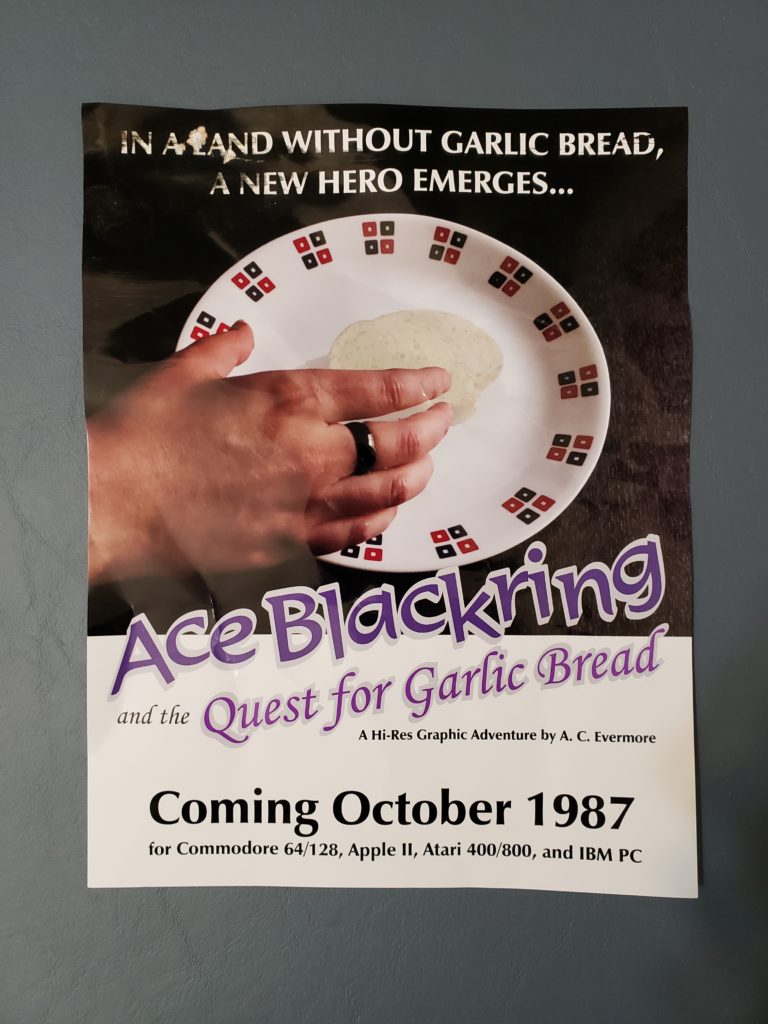
WHAT.
IS.
THIS.
I don’t think I ever “Buy It Now”ed something so fast. Three days later, it was in my hands.
From the tapemarks on the back, it looks like this was a promotional poster that was probably put in the front window of the store to advertise the game. It’s not the best looking poster in the world, but there was a lot of bad photography masquerading for game ads in those days, so I’m not going to hold that against it.
With a name like “Ace Blackring” and a mention of garlic bread, you’d assume it’s an asexual-themed game, but it could just be coincidental. After all, “Ace of Aces” isn’t a game about someone trying to out-asexual all the rest of the people and become the president of the local meetup group. But the picture solidifies it. Black ring, right middle finger. Clear as day.
So how come I’d never heard of this game? And how can I get a copy?
A New Hero Emerges
It’s not easy to research the history of video games that aren’t from our timeline. It took me two years of diving into archives, pestering collectors, and scouring old computer magazines to dig up enough material for this post.
One piece of information I already had: I recognized the name listed on the ad. A.C. Evermore was one of Terrace Spring’s most prominent authors, having written “You Are Asexual”, “The Quiver of Aros”, and “Queer Space Patrol”, among countless others. Each of these gamebooks sold dozens of copies. My research found that Terrace Spring tapped Evermore to write the new game, so that audiences would know that they were getting signature Terrace Spring quality. (Having read You Are Asexual and parts of Queer Space Patrol, “quality” would not be a word I’d use for what comes out of Terrace Spring, but anyway…)
The game is a graphic adventure. These days, that means a point and click game, maybe even a fully-rendered realistic 3D world, but in those days, it meant a text adventure with pictures. With well-known behemoths like Infocom and Sierra On-Line already firmly established in the space, Terrace Spring and Evermore were going to have an uphill battle. With that in mind, they decided to carve out a niche, as they had done with the Celebrate Your Own Identity series, and leverage the power of their existing audience.
The Celebrate Your Own Identity books were queer-themed multiple-choice gamebooks. Each one focused on a character of a particular identity. In “You Are Asexual”, you were an asexual student fighting the administration at a fascist high school. In “Mx. It Up”, you were a non-binary bar brawler. In “The Quiver of Aros”, you were an aromantic time-travelling cyborg archer trying to take down an evil corporation. The planned games would be similar, although slightly more covert in their queerness.
But what should the game be about? When executives at Terrace Spring planned the development and production cycle of the game, they came up with a target release date in the middle of October, and immediately had their theme. Mid-October would be perfect timing for the gift-giving season around Ace Week, or, as it was still known in those days, Asexual Acceptance, Understanding, and Empowerment Day, which was observed on the Thursday closest to 10/24. And thus, Ace Blackring entered development in January of 1987.
As far as I can piece together from the scanned copy of a partially revealed invisible ink hintbook, in the game, you play as “Ace Blackring”, who lives in a town between the old west and the high seas. The story seems to be that all the garlic bread in town was destroyed in a fire, and now you’re on a quest to find more. You have to deal with pirates and cowboys and “Sheriff Manatee”, who I think is actually a manatee. There are lots of ace jokes, like not being influenced by some sirens, or using a condom as a balloon. The game seems like it’s a mishmash of genres and time periods and from the outline I have, I can’t tell if it works or not. For that, I’d have to play it, and to play it, I’d need to track down a copy.
So what do you think I did next?
Complete In Box, Like New Condition
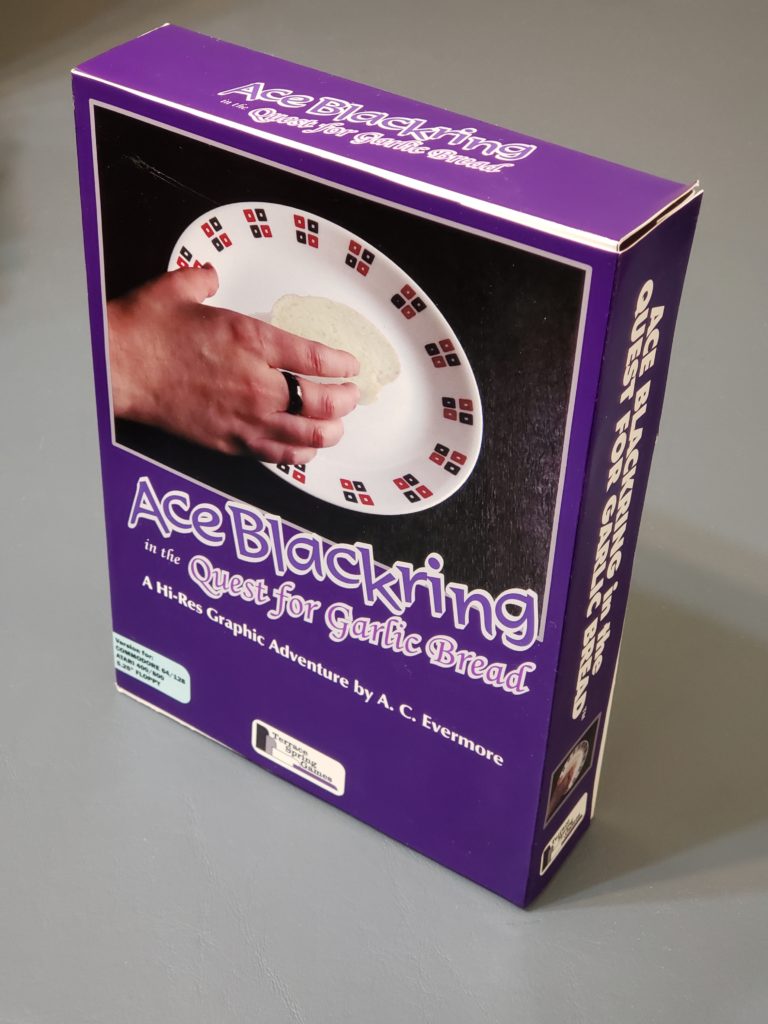
Here we are, 35 years later and beyond the boundaries of reality, but I finally managed to track down a complete, in box copy of this game! Check out that box art.
First, they reused the same photo from the ad for the cover. The hand reaching for a piece of ghost garlic bread doesn’t really grab me, you know? But there it is. And honestly, there have been worse pieces of cover art than this. Not many, but some…
The second thing to note is the subtle change in the title. The ad said “and the”, while the box says “in the”. I honestly don’t know whether that was an intentional marketing change, a mistake, or if this copy of the game found its way into our universe from a different reality than the ad. Either way, interesting to note.
This copy is for both the Commodore 64 and the Atari 400/800. Companies used to use this multi-format release technique as a way to save money and reach both markets. They wouldn’t have to worry about having different inventory for C64 vs. Atari, and customers would be more likely to find the copy of the game for their computer. (Well, except for the fact that most places that sold games for computers would separate the software by computer type, so it would’ve ended up on the shelf with either the C64 games or the Atari games and owners of the others would never see it, but whatever…) The Commodore 64, being the best computer, almost always was on Side A of the disk.
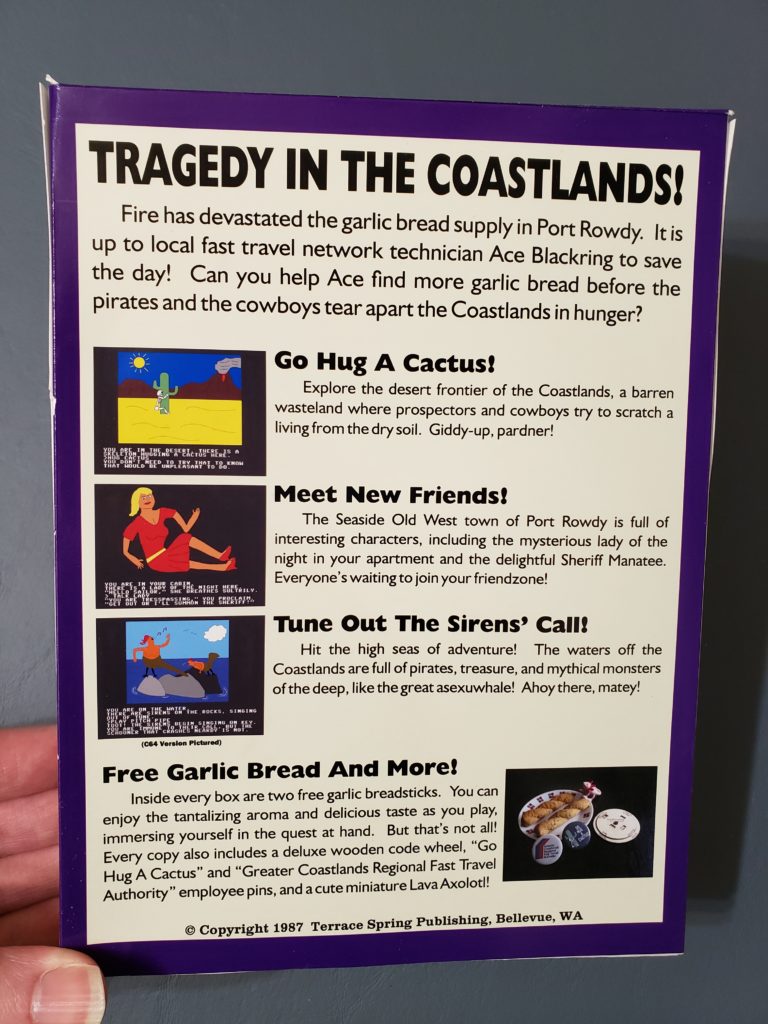
Tragedy in the Coastlands! A fire has destroyed all the garlic bread, and you embark on a quest to get more. Honestly, sounds like a better story than trying to rescue the princess from the evil wizard for the thousandth time.
And check out those graphics! Hi-Res indeed!
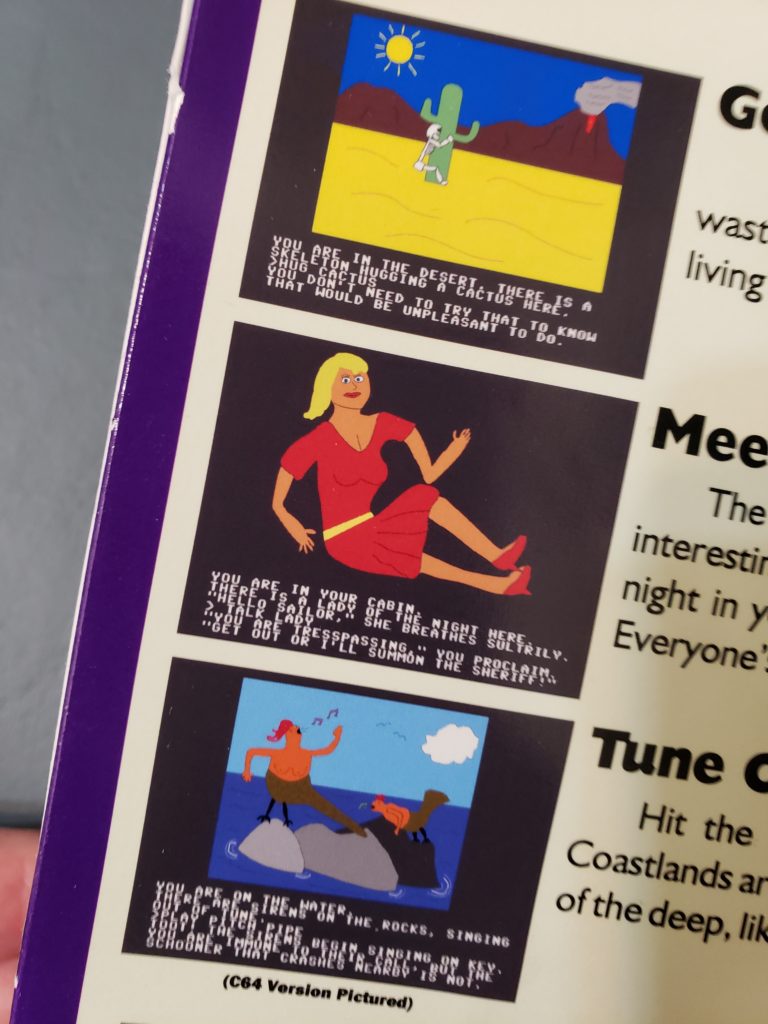
I’m going to have nightmares now.
Admittedly, graphics for many of these types of games were really really bad, because the tooling to support graphical design on these computers was really really bad. You could do some phenomenal graphics despite the technological limitations, but most games, especially adventure games, didn’t. Good graphics were hard to do and took up a lot of disk space, and when you have 50 locations to draw, sometimes with multiple states, that is a lot of work for not much gain. After all, much of the competition (like genre-leading Infocom) didn’t even have graphics at all.
But seriously, though, technology aside, what the hell even are those things on the bottom picture? They’re supposed to be sirens?
Anyway, enough of the outside, let’s open it up and see what lies inside.
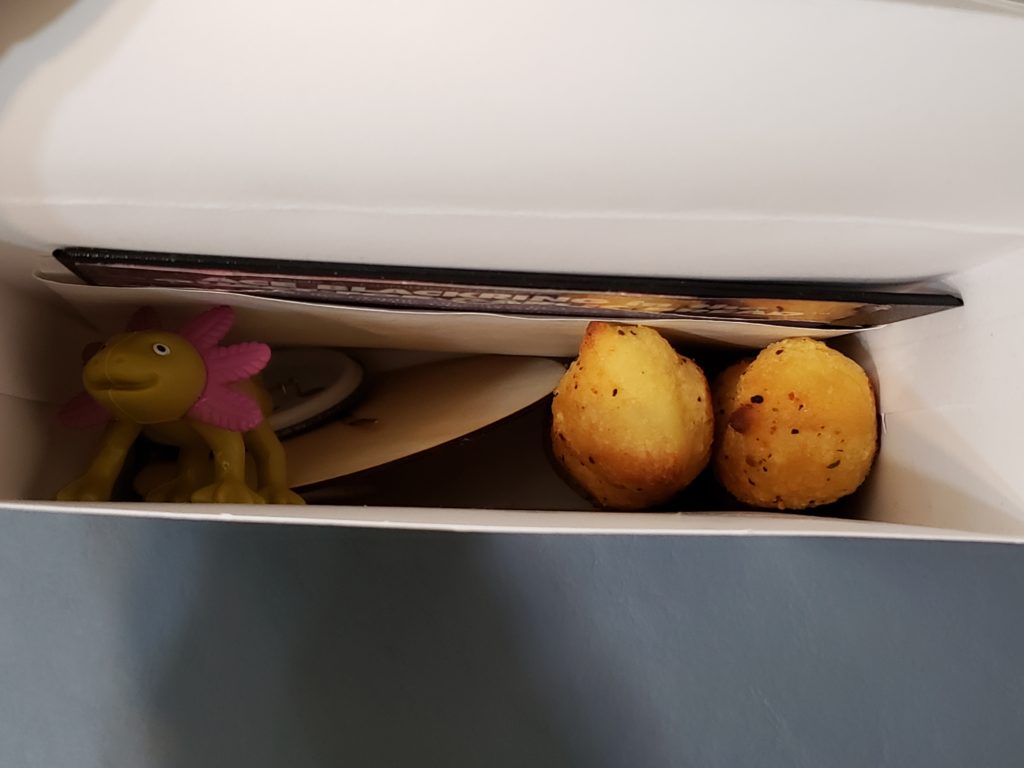
OMG. FEELIES!
I love feelies!
Feelies were a gimmick used by game publishers in the 80’s. Essentially, they were little Cracker Jack Toys (Cracker Jack still had toys back in the 80s, too.) inside the game box. They were meant to increase immersion and were sometimes used as copy protection, but usually they were just little toys. Let’s see what we have here…
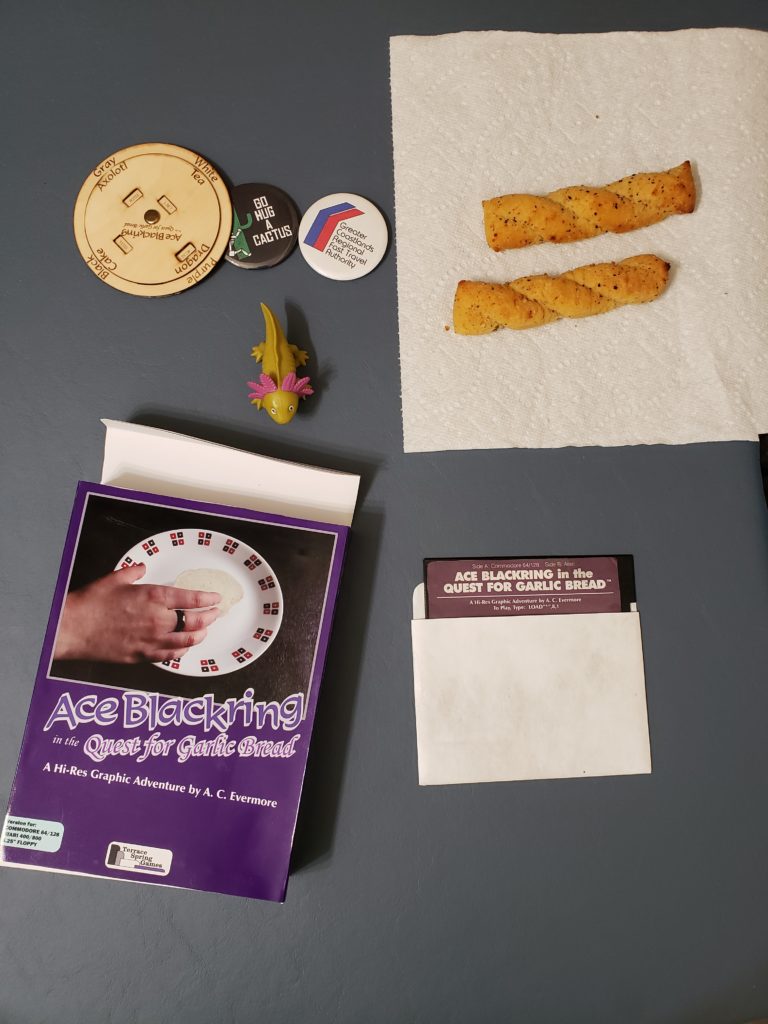
Okay, so first of all… GARLIC BREAD. This game came with GARLIC BREAD.
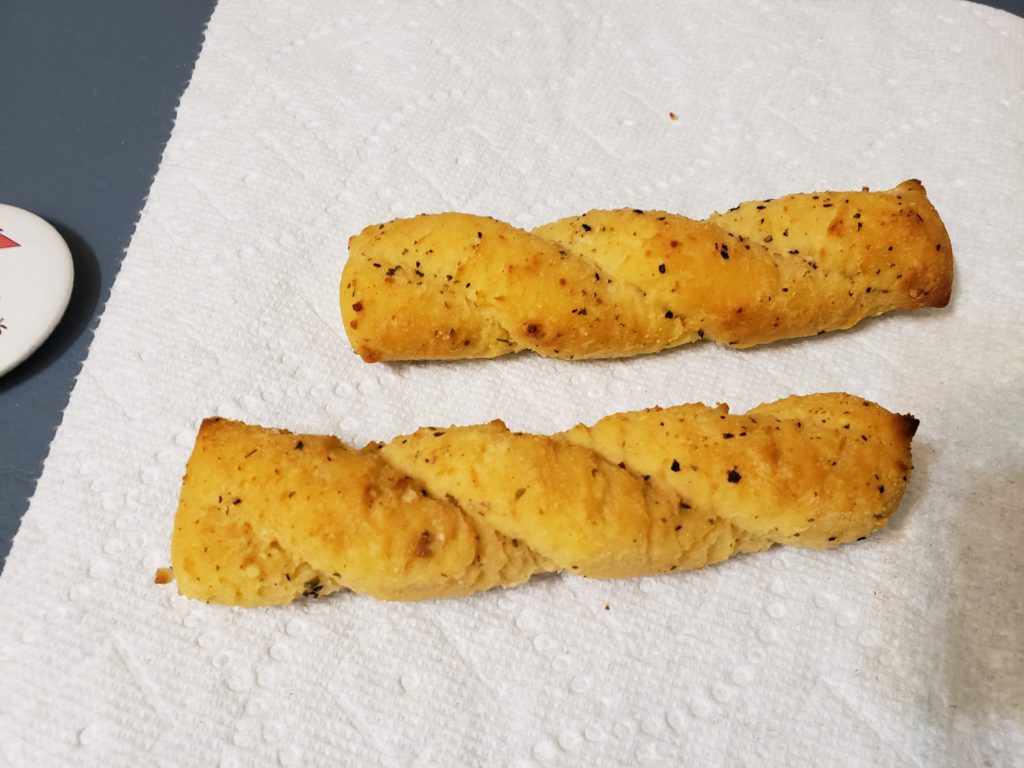
And that’s not some plastic or cardboard replica of garlic bread, it’s the real deal, two authentic, genuine garlic breadsticks. I honestly can’t decide if that’s the most awesome pack-in item ever or the most disgusting. They were just loose in the box, which is really weird. I’m honestly surprised the box and everything in it wasn’t stained beyond recognition after 35 years of touching garlic bread grease. I’d warm them up and let you know how they were, but they’re from 1987 (and from another universe), so I’m not gonna do that.
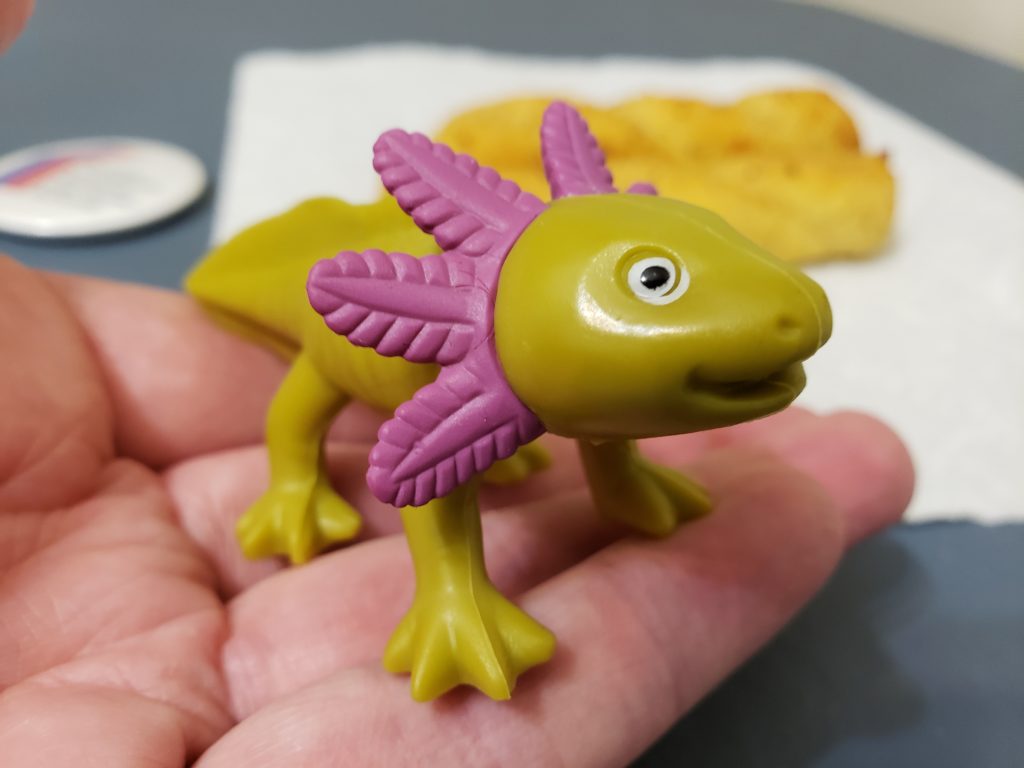
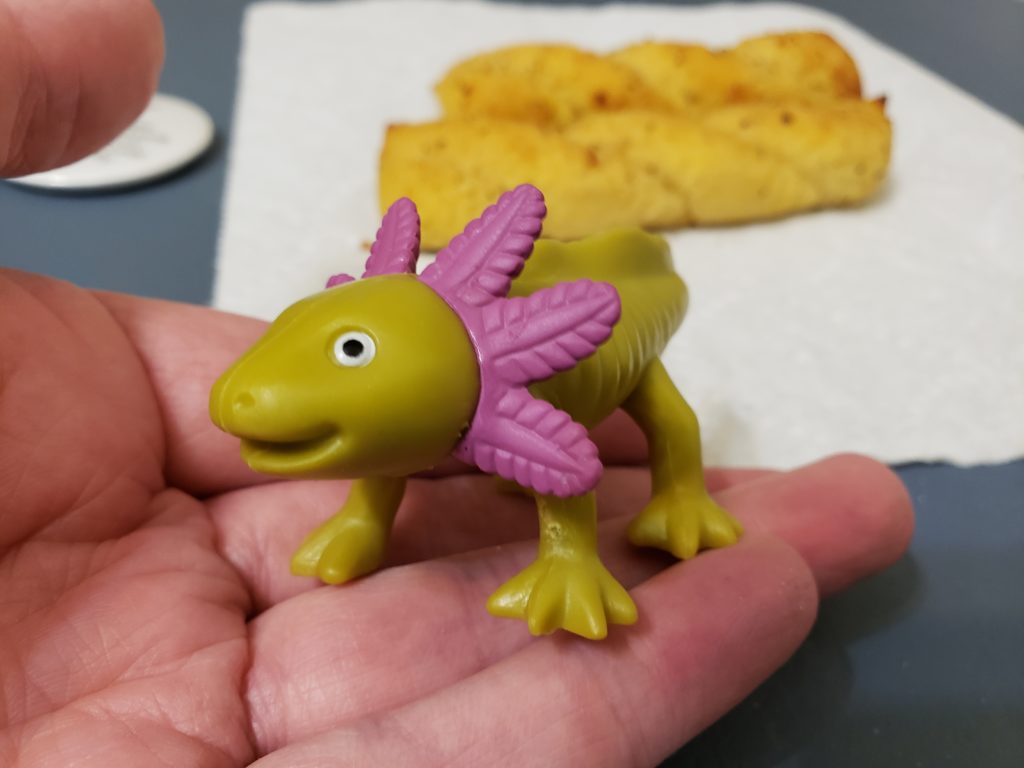
Next up is this cute little axolotl figurine. I’m not sure what it has to do with the game, but since it’s a feelie, it’s bound to be something important. The box called it a “Lava Axolotl”, but it doesn’t really look all that lava-y to me. The image on the box also showed a pink one, but I got one that’s green with purple fronds. I wonder how many colors there were and if there’s something special about each one. I’m gonna take this little friend into work and sit them on my desk.

There were also these two pinback badges. One features the popular “Go Hug A Cactus” command, inviting someone to do something that they know would be unpleasant without needing to try it. It’s fascinating that asexual meme culture produces the same results across time and space. The other button is for something called the “Greater Coastlands Regional Fast Travel Authority”, which I’m sure is something that would be exciting to someone who’s played the game, but I haven’t played the game, so I have no idea what that’s all about.
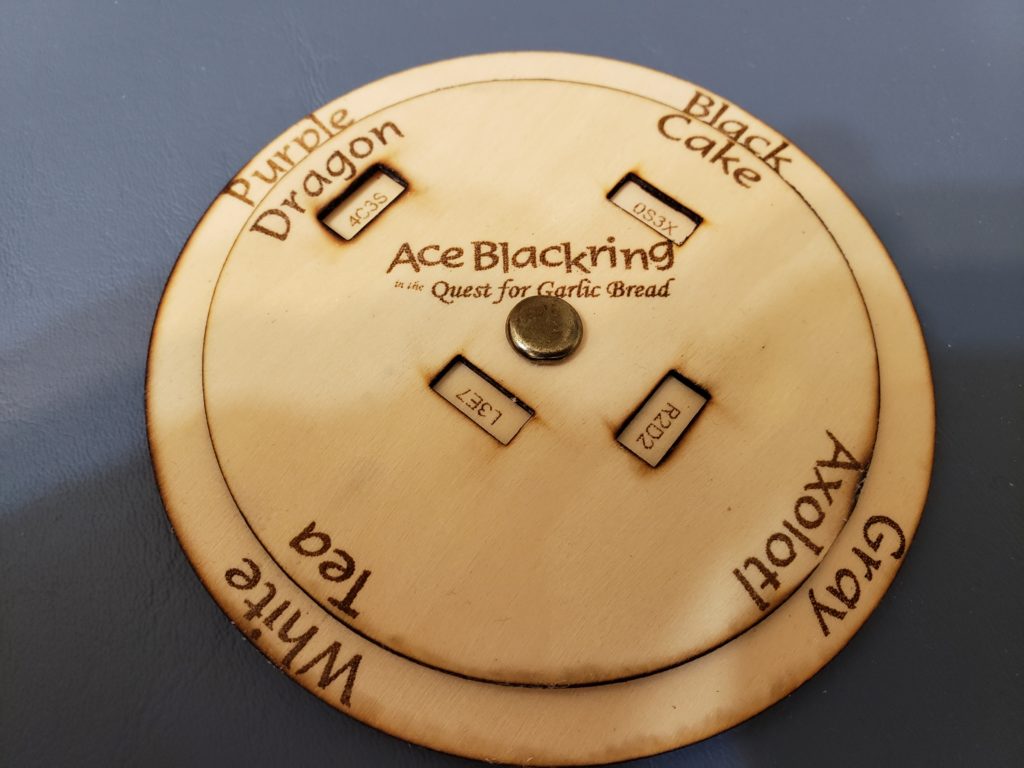
The last feelie is a wooden code wheel. Code wheels were a copy-protection mechanism employed by some game makers. They ensured that someone with a pirated copy of the game disk couldn’t play very far into the game. They were comprised of several independently rotating discs, with small windows in them. At some point in the game, usually fairly early on, there would be a prompt for a secret code using the wheel. For instance, the game might ask about a “Purple Dragon”, and expect “4C3S” in response, but if it asked for “Gray Tea”, you’d have to rotate and look up the code.
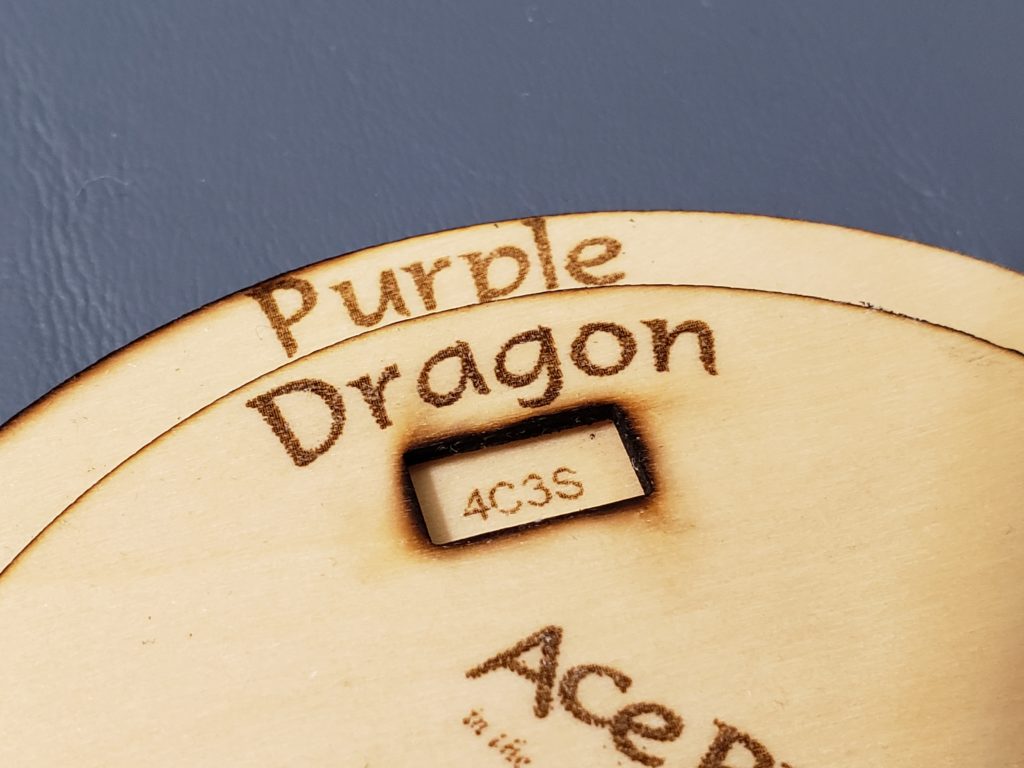
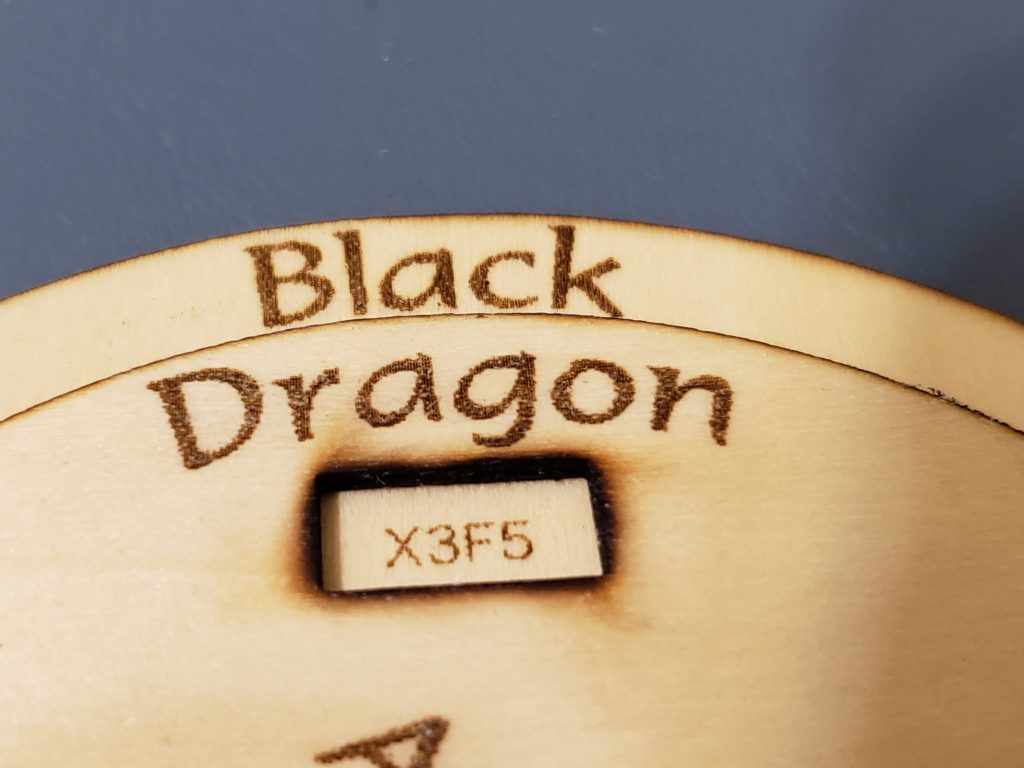
Usually, these code wheels were made out of cardboard. I don’t think I’ve ever seen one made out of wood before.
Unfortunately, this code wheel isn’t very complex. Most code wheels had dozens of options, with hundreds, if not thousands of combinations, making it difficult or impossible to provide a list of answers along with the copied disk. This one has a total of 16 options. That would be very easy to write down. Some people could even memorize the entire list. While it’s interesting as an object, it’s next to useless as an anti-piracy device.
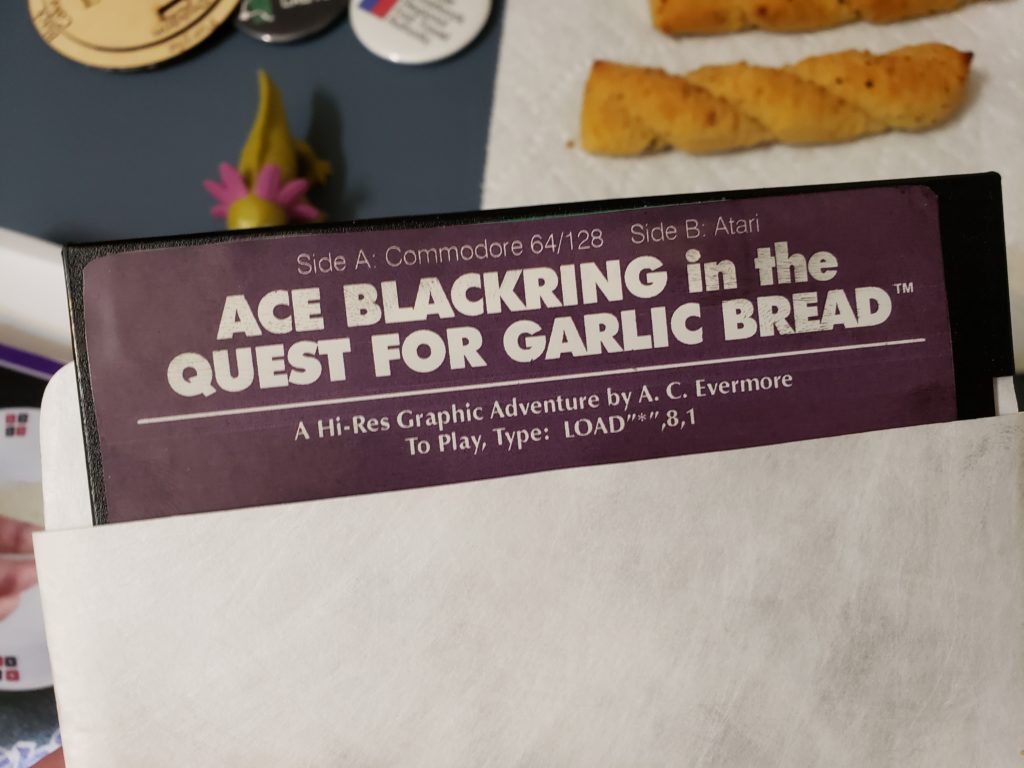
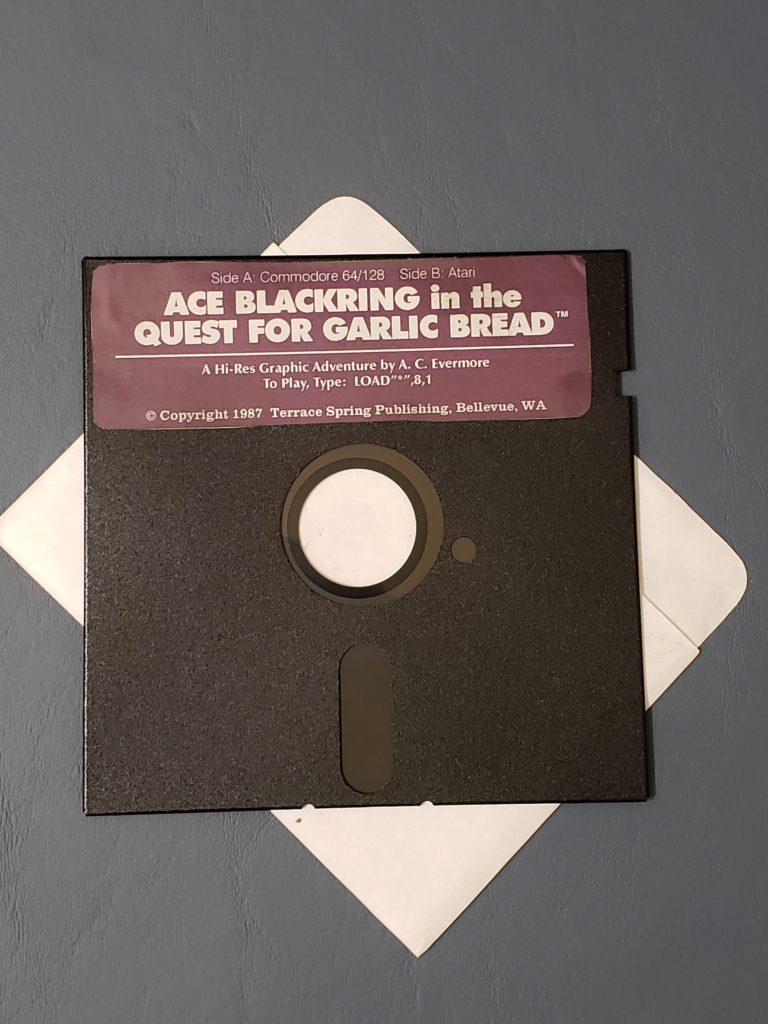
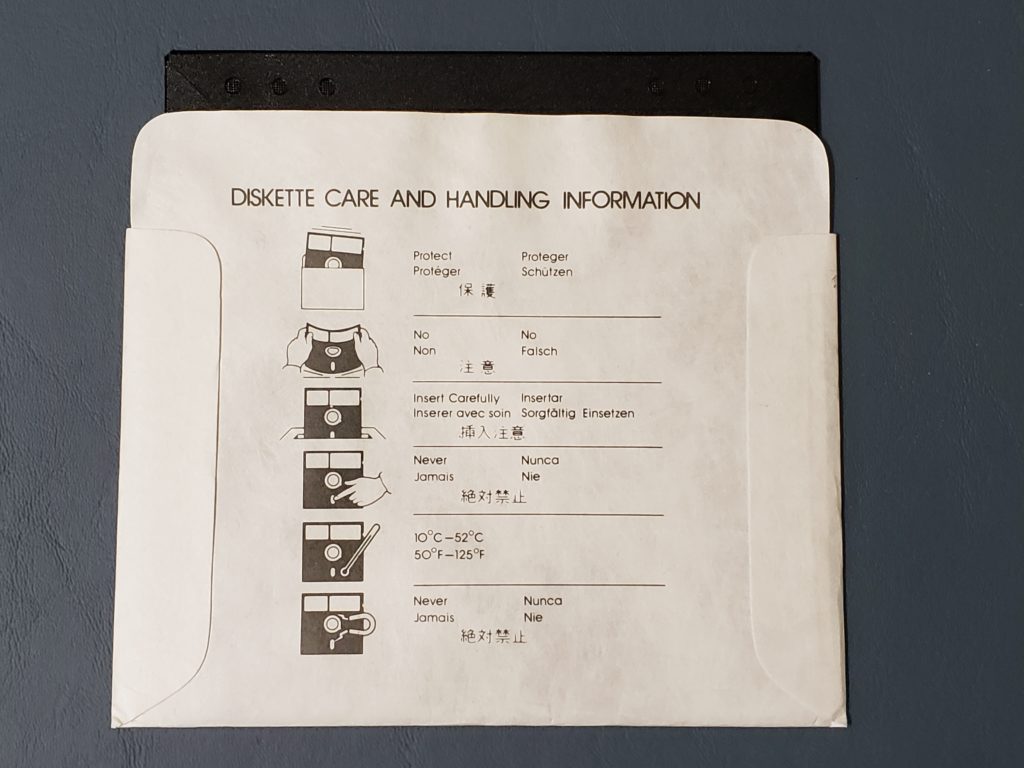
The final item in the box is the game disk. It’s a standard 5 1/4″ inch floppy, containing both the Commodore 64 version and the Atari 400/800 edition. If you’ve never seen a floppy, this is what they looked like. The envelope has the standard Rosetta Stone of Magnetic Media Dangers on the back.
Let’s Play!
This is the part of the post where I’d love to show you screengrabs and video from the game itself. I’d love to give a plot synopsis and dissect all the cultural references and marvel at the state of the ace community in 1987 and do all that stuff.
But I can’t.
I popped it in my trusty 1541-II, typed LOAD "*",8,1 as I’ve done so many times before, and…
Shhhshhhshhhshhshhh-crkcrkcrckcrk-shsh-crkcrkcrkcrk-shshshshshsh…
blinkblinkblinkblinkblinkblink.
Anyone who’s owned a Commodore knows the gut-wrenching horror of that sequence of events. The disk drive tries to read the disk, fails, makes a horrendous knocking sound, tries again, and then fails silently, the LED eternally blinking in despair.
The disk doesn’t work.
The back of the disk envelope doesn’t mention any dangers associated with interdimensional travel, but I’d imagine that whatever it was that brought this game to our universe probably involved a strong magnetic field.
The disk is frotzed. I can’t save the garlic bread.
Words do not begin to describe how disappointed I am.
And Then What?
My research indicates that Ace Blackring was the only game Terrace Spring ever released. I wonder if it’s because the game wasn’t any good or because all the fans were poisoned by that garlic bread. There are some references to a follow up game called “Quiver Arostone vs. the Onslaught of Amatonormativity”, but as far as I can tell, that didn’t exist beyond a vague “Coming Soon” promise on the Blackring’s warranty card. A.C. Evermore went back to writing the Choose Your Own Identity series, releasing the bestseller “What Is Love?” in February of 1988.
